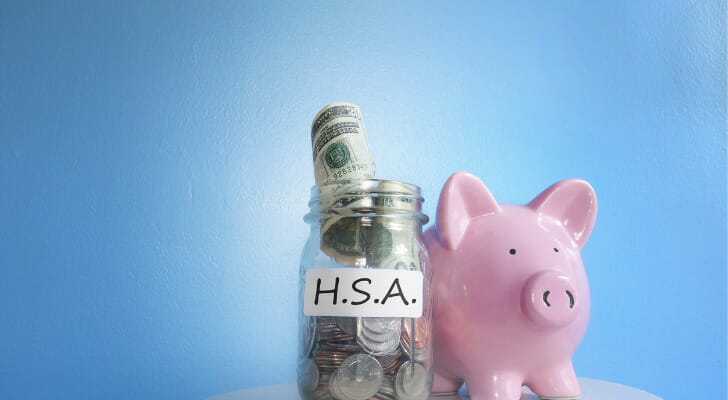Health savings accounts or HSAs help offset your out-of-pocket healthcare costs when you have a high-deductible health plan (HDHP). Because of all the tax advantages that come with the account, it’s a great strategy to save for medical expenses in retirement. Taking a look at the average HSA balances by age can help you see how you stack up. While it’s wise to take advantage of your HSA, you’ll also need a retirement plan beyond it. If you’re unsure of where to start, try working with a financial advisor.
What Is the Average HSA Balance By Age?
The average HSA balance for a family is about $7,500 and for individuals it is about $4,300. This average jumps up to $12,000 for families who invest in HSAs. Here’s a breakdown of the average HSA balance by age.
Average HSA Balance By Age
| Average Age | Average Household Income | Average Total Assets | Average Investment Balance |
| 43 | $72,762 | $6,069 | $3,612 |
| 48 | $73,748 | $6,067 | $91 |
| 50 | $73,296 | $7,079 | $6,401 |
| 58 | $72,701 | $26,837 | $20,459 |
| 59 | $83,557 | $36,763 | $35,896 |
How Much Should I Contribute to My HSA?
When deciding how much you should contribute to an HSA, there are a few things to consider. First, HSA contribution limits increased by $50 in 2022 for self-only coverage, from $3,600 to $3,650. Folks with family plans can contribute up to $7,300 in 2022, which is $100 up from 2021. If you’re 55 or older, you can contribute an extra $1,000 into your HSA account.
Maxing out an HSA helps you leverage the numerous tax advantages that come with the account. HSA contributions are tax deductible, which means they are subtracted from your taxable income. Also, as the account holder you can invest the money in the account, and it can earn tax-free interest. Plus, if you take a distribution after age 65, you won’t have to pay taxes on the total amount withdrawn.
If maxing out your HSA is not in the cards for you, you can select a different amount. Some employers may match your HSA contributions or contribute individually. If your employer contributes to your account, it’s essentially free money you can use toward qualifying medical expenses within the year or savings for future medical costs. You can use the money for items like Band-Aids, glasses, contact lenses or visits to the doctor.
If you have funds left over at the end of the year, you can roll the account balance over to the next year to pay for qualifying expenses.
What If I Have a Below-Average HSA Balance for My Age?
Concerns about a smaller amount in your HSA are understandable, especially if you haven’t been making regular contributions to your account. Getting a jump start on a savings account is always ideal, but you can take steps to make up for lost progress.
One way is to start putting as much money into the account as soon as you can. This can be a challenge, but reducing your monthly expenses can give you extra cash to put into your HSA. You can allocate more income towards your savings by getting rid of that second car or a Netflix subscription, addressing any debts you may still have can help.
You can also give yourself a few more years before retiring. While this is not a perfect substitute for the missed years of your account growing by compounding interest, the extra years of income will help pad your account. An extra perk of waiting a year or two longer to retire is that your Social Security benefits increase. While Social Security benefits probably won’t be sufficient to retire on, they will defray some of your cost of living while retired.
HSA Alternatives
You have ownership of your HSA, even if you change jobs. But keep in mind that changing your health plan in the middle of the year may mean that it will no longer be possible to make contributions to your account. If that occurs, the number of months you had an HSA-eligible plan determines the highest amount you can put towards your HSA.
If you’re no longer eligible, here are a few alternatives worth considering.
401(k)
People with a 401(k) plan can make pre-tax contributions from their paychecks as a way to lower taxes they owe on their income. As long as the funds stay in the 401(k) account, workers can take advantage of a retirement account that decreases their annual taxable income.
Since individuals put away pre-tax dollars in their 401(k), the funds are taxed as they are withdrawn from the account during retirement. Keep in mind that a Roth retirement account takes a different route: the federal government withholds income tax first, and then money goes into the account. When you withdraw funds from a Roth IRA during retirement, the federal government does not apply further taxes on these dollars.
If you don’t currently max out your contributions, a salary increase, bonus or lump sum windfall is a good time to increase your contribution amount. For example, if your salary increases 3%, you could use 1–2% of that for your retirement contributions. The table below shows average salary and average 401(k) balance by age range.
Average 401(k) Balance by Age
| Age Range | Average Income | Average Balance |
| <25 | $34,684 | $6,718 |
| 25-34 | $49,920 | $33,272 |
| 35-44 | $58,604 | $86,582 |
| 45-54 | $59,904 | $161,079 |
| 55-64 | $59,540 | $232,379 |
| 65+ | $52,416 | $255,151 |
Traditional IRA or Roth IRA
A host of retirement accounts are available to you to pay for health care costs in the future. By maxing out your total annual contributions, you can take full advantage of what these accounts offer. As explained above, traditional and Roth IRAs differ in how taxes are applied to contributions. As with a 401(k), traditional IRA contributions are tax deductible.
Then in retirement you must pay income tax on all distributions. At the same time, you can contribute to a Roth IRA with after-tax dollars. Then in retirement, you can receive tax tax-free distributions. For 2022, contribution limits for both accounts are $6,500 and $7,500 for folks 50 or older.
Emergency Fund
If you’re nearing your expected retirement age, it is wise to start creating an emergency fund sufficient to meet unanticipated medical bills down the line.
Your emergency fund will serve as a readily available source of cash. It will allow you to address surprise medical expenses, such as a new, expensive prescription.
Note that the bank account holding your emergency fund is a double-edged sword. While it will never be a problem to withdraw your money, the account will have a minimal interest rate.
The Bottom Line
According to the Fidelity Retiree Health Care Cost Estimate, couples who retired at age 65 in 2021 could need roughly $300,000 in savings (after tax) to pay for healthcare expenses in their golden years. Contributing to an HSA can help you plan and save for these expenses. But, if you don’t qualify for an HSA, you can contribute to a 401(k), IRA and a Roth IRA and use the funds for future medical expenses. In addition, if you can max out your retirement account contribution then setting up an emergency fund will also allow you to pay for unforeseen health costs.
Tips on Healthcare
- Consider working with a financial advisor as you consider updating or revising your healthcare plans. Finding a qualified financial advisor doesn’t have to be hard. SmartAsset’s free tool matches you with up to three financial advisors who serve your area, and you can interview your advisor matches at no cost to decide which one is right for you. If you’re ready to find an advisor who can help you achieve your financial goals, get started now.
- Another important thing to think about is life insurance. Use SmartAsset’s free life insurance calculator to see how much you need so you can make any adjustments you need to.
Photo credit: ©iStock.com/zimmytws, ©iStock.com/Umida Kamalova, ©iStock.com/AndreyPopov


